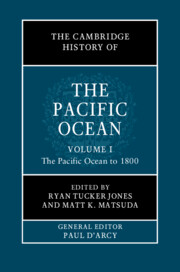Book contents
- The Cambridge History of the Pacific Ocean
- The Cambridge History of the Pacific Ocean
- The Cambridge History of the Pacific Ocean
- Copyright page
- Contents
- Figures
- Tables
- Contributors to Volume I
- Frontispiece
- General Editor’s Introduction
- Preface to Volume I
- Part I Rethinking the Pacific
- 1 Te Moana Nui a Kiwa
- 2 The Pacific Region in Deep Time
- 3 Leviathan’s Families
- 4 Weaving Women’s Stories
- 5 The Pacific World
- Part II Humans and the Natural World in the Pacific Ocean
- Part III Deep Time: Sources for the Ancient History of the Pacific
- Part IV The Initial Colonization of the Pacific
- Part V The Evolution of Pacific Communities
- Part VI Europe’s Maritime Expansion into the Pacific
- References to Volume I
- Index
3 - Leviathan’s Families
The History of Humans and Whales in the Pacific
from Part I - Rethinking the Pacific
Published online by Cambridge University Press: 11 November 2022
- The Cambridge History of the Pacific Ocean
- The Cambridge History of the Pacific Ocean
- The Cambridge History of the Pacific Ocean
- Copyright page
- Contents
- Figures
- Tables
- Contributors to Volume I
- Frontispiece
- General Editor’s Introduction
- Preface to Volume I
- Part I Rethinking the Pacific
- 1 Te Moana Nui a Kiwa
- 2 The Pacific Region in Deep Time
- 3 Leviathan’s Families
- 4 Weaving Women’s Stories
- 5 The Pacific World
- Part II Humans and the Natural World in the Pacific Ocean
- Part III Deep Time: Sources for the Ancient History of the Pacific
- Part IV The Initial Colonization of the Pacific
- Part V The Evolution of Pacific Communities
- Part VI Europe’s Maritime Expansion into the Pacific
- References to Volume I
- Index
Summary
In late 1805, the members of the United States government’s Lewis and Clark expedition became the first Americans to travel overland to the shores of the Pacific Ocean. Greeting the expedition with endless rain and cold, the Pacific largely disappointed. But, there was one moment of intense interest. On 5 January 1806, the group received word from the Clatsop Indians in present-day Oregon that a huge whale carcass had washed ashore at a place called Ecola, the local word for cetaceans. Expedition leader William Clark headed out to see it, but as he readied to leave, a woman named Sacagawea insisted on coming with him. A former slave who had lived her entire life inland among the Rocky Mountains, Sacagawea was the expedition’s only Native American, only woman, and only member to have brought a child. ‘She observed’, the logbook notes, ‘that she had travelled a long way with us to see the great waters, and that monstrous fish was also to be seen, she thought it very hard she could not be permitted to see either.’1 Clark found the request pushy and importunate, disruptive of the racial and gender hierarchies that reigned on the expedition. Nevertheless, he relented. After a laborious day of hiking, the two were led to the rotting remains of a whale Clark measured at 35 metres long, surely a blue whale, the largest animal ever to have lived on Earth.
- Type
- Chapter
- Information
- The Cambridge History of the Pacific Ocean , pp. 64 - 90Publisher: Cambridge University PressPrint publication year: 2023



